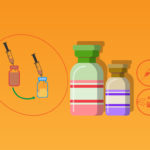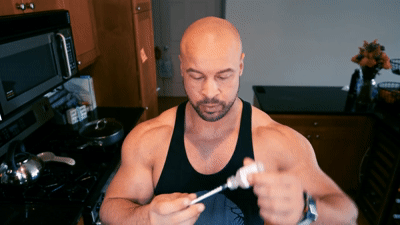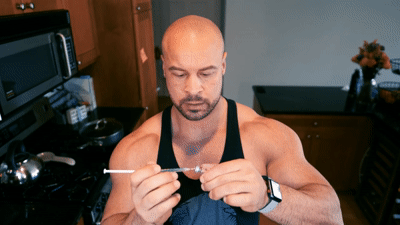 Before really going straight into the topic, let’s first understand the need for the phrase “reconstituting peptides”.
Most peptides that you will see are often sold as lyophilized peptides which means that (freeze-dried) powder form.
Before really using the peptide, you will have to add liquid to the powder and MIX it well to make it a solution but it isn’t as simple as it sounds!
So, you will need alcohol swabs, a syringe (27-29 gauge insulin needles), the lyophilized peptide that you have ordered, and the bacteriostatic water or sterile water, depending on your preference. (I would personally recommend bacteriostatic water because of its longer shelf-life).
The first step is to use the alcohol swab and wipe the vials containing lyophilized peptides and the bacteriostatic/sterile water. Give half a minute for the alcohol to dry so that there is no risk of bacterial growth.
The second step is to use your syringe and draw out 1ml of bacteriostatic water from the vial without really touching the needle as it could cause contamination. For those of you thinking about the volume of water, 1ml is usually enough for all the peptides available in the market.
Before really going straight into the topic, let’s first understand the need for the phrase “reconstituting peptides”.
Most peptides that you will see are often sold as lyophilized peptides which means that (freeze-dried) powder form.
Before really using the peptide, you will have to add liquid to the powder and MIX it well to make it a solution but it isn’t as simple as it sounds!
So, you will need alcohol swabs, a syringe (27-29 gauge insulin needles), the lyophilized peptide that you have ordered, and the bacteriostatic water or sterile water, depending on your preference. (I would personally recommend bacteriostatic water because of its longer shelf-life).
The first step is to use the alcohol swab and wipe the vials containing lyophilized peptides and the bacteriostatic/sterile water. Give half a minute for the alcohol to dry so that there is no risk of bacterial growth.
The second step is to use your syringe and draw out 1ml of bacteriostatic water from the vial without really touching the needle as it could cause contamination. For those of you thinking about the volume of water, 1ml is usually enough for all the peptides available in the market.


Now that you know the general peptide reconstitution guidelines, let’s talk about some of the exceptions.
While most of the peptides will be in bacteriostatic water and sterile water, some really won’t, and this will be depending on the polarity of the peptides.
To know the best solvent in which a peptide will be soluble, you must have to consider some biochemistry knowledge and do some trial and error.
Acidic peptides will be best soluble in basic solution and vice versa. Researchers also use organic solvents such as Acetic acid and DMSO to dissolve hydrophobic peptides and polar uncharged amino acids.
Note that sodium chloride water shouldn’t be used as it may result in precipitates.
Once the peptide is made soluble in any of the relevant solutions, diluting it with bacteriostatic water or sterile water is recommended.
Can you reconstitute peptides with distilled water?
Yes, distilled water can also be used to reconstitute peptides alongside bacteriostatic and sterile water. But not all peptides dissolve in water easily, so it usually is recommended that you try to dissolve the peptide in any of these waters using Sonication. This process is often helpful in breaking down the big solid lumps of peptides in the water and aids in the dissolution process. If the peptide still doesn’t get dissolved, perform trial and error and use various other solvents.How to Store Reconstituted Peptides
Reconstituted peptides can be stored in several ways, depending on the duration of storage and the desired shelf life. Here are some general guidelines for storing reconstituted peptides:- Short-term storage: If you plan to use the reconstituted peptide within a few days, you can store it at 4°C in the dark. It is essential to avoid exposure to light and high temperatures, which can lead to peptide degradation.
- Long-term storage: For long-term storage, it is recommended to aliquot the reconstituted peptide into small volumes and freeze them at -20°C or -80°C. This method can preserve the peptide’s stability and activity for several months to years, depending on the peptide’s properties and storage conditions.
- Freeze-drying: Freeze-drying, also known as lyophilization, is a method that removes water from the peptide solution and allows the peptide to be stored in a stable, dry form at room temperature for an extended period. However, this method requires special equipment and expertise.
- Avoid repeated freeze-thaw cycles: It is essential to avoid repeated freeze-thaw cycles, as they can cause damage to the peptide and decrease its stability and activity.
How to mix peptides in the same syringe?
Well, people have been mixing peptides in the same syringe and then administering them. Only if the peptides are of the same nature such as growth hormone (GH) influencers or if you see any vendors selling a stack of particular peptides, only those you should mix. The process is simple. All you have to do is add the desirable reconstituted peptides in 1 vial and then use the syringe to pull out the mixture so that you can administer it.How long does bacteriostatic saline last?
If kept under appropriate conditions, bacteriostatic saline can last up to 28 days.
Why is there a shortage of sterile water?
While there is not a long-term shortage, an acute shortage is often seen because of either manufacturing facilities malfunction’ or some medical emergency such as COVID-19.
